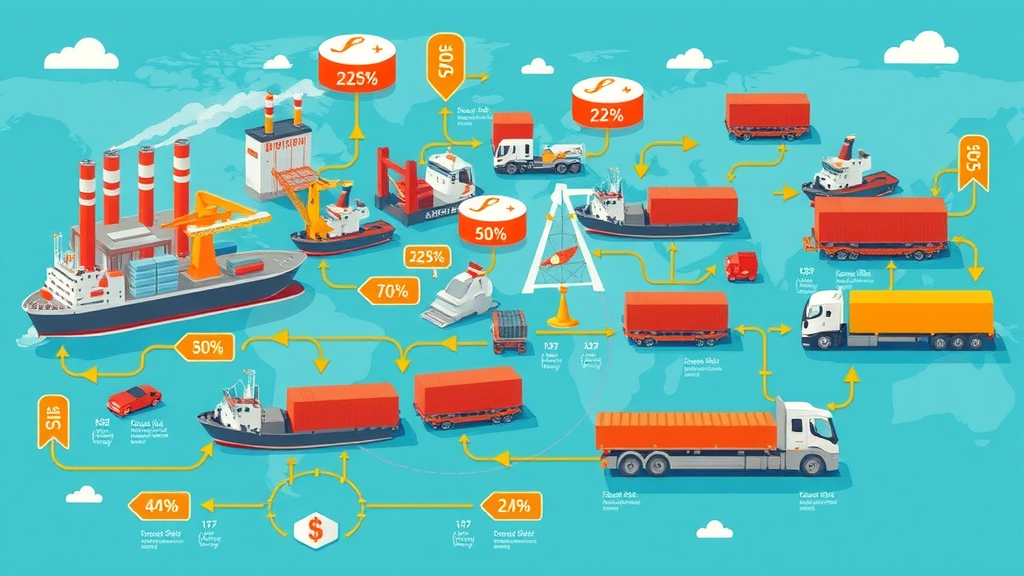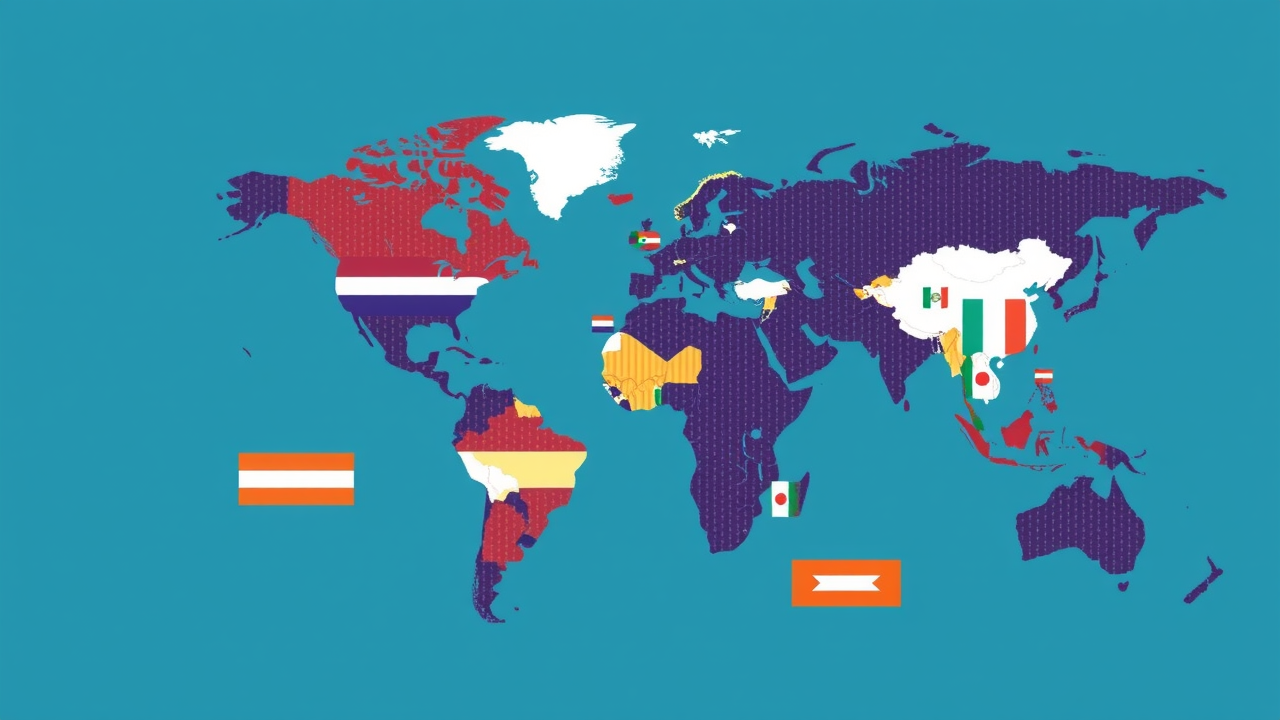Did you know that one mistake in trade policy compliance can cost U.S. manufacturers millions of dollars? Navigating international trade rules isn't just paperwork — it's your key to global growth and competitive advantage. In this essential guide, discover how the right trade policy knowledge can shield your business from costly errors and unlock new markets around the world.

Unveiling the Impact: Why Trade Policy Matters for Manufacturers
Over $2 trillion in U.S. exports are shaped by trade policy each year—one misstep can cost manufacturers millions.
Trade policy is not just a concept that sits on the desks of diplomats and lawmakers—it's a lifeline, or a landmine, for manufacturers. Every year, U.S. factories ship trillions in goods to trading partners worldwide, and virtually every shipment is governed by a web of trade agreements, tariffs, quotas, and compliance rules. Because of this, manufacturers in the United States must pay close attention to both international trade policy and evolving U.S. trade policies. A single oversight—like failing to comply with a rule of origin under a free trade agreement or not securing proper export control documentation—can trigger massive fines, lost market access, or delays that ripple down the global supply chain.
But trade policy is more than risk management—it's a powerful tool for competitive growth. By strategically using free trade agreements, understanding the 7 instruments of trade policy, and staying up to date on current trade rules, manufacturers can cut costs, enter new markets, and forge strong relationships with global trading partners. In this guide, we'll break down complex international trade topics in simple language while putting a spotlight on actionable steps U.S. manufacturers can take to thrive in a rapidly changing world economy.
Understanding the nuances of tariffs and free trade agreements is especially important for companies engaged in North American trade. For a closer look at how recent changes in tariff structures between the U.S., Mexico, and Canada are impacting import-export operations, explore the detailed analysis in what lower tariffs on Mexico and Canada could mean for import-export companies.
What You'll Learn in This Comprehensive Trade Policy Guide
- The fundamentals and definition of trade policy
- Types of trade agreements and their significance
- The 7 instruments of trade policy
- How trade policy affects manufacturers
- Case studies and real-world examples
- Frequently asked questions on trade policy
Defining Trade Policy: Core Concepts for International Trade
What is Trade Policy?
At its core, a trade policy is a set of laws, agreements, and regulations that a country uses to govern international trade. Think of it as the official rulebook American manufacturers, exporters, and importers must follow when moving goods or services across borders. Trade policy covers everything from taxes on imported goods (tariffs), rules limiting the amount of imports (quotas), to export controls that regulate the flow of sensitive technology. For any manufacturer that deals with global supply chains, understanding trade policy isn’t optional—it's essential for survival and growth.
Trade policy shapes how businesses interact with their trading partners, determines tariff rates, and outlines the requirements for complying with international trade rules. It negotiates the balance between protecting domestic industries and promoting competition, and plays a direct role in determining whether your company pays a costly import tax or enjoys tariff-free access under a trade agreement. As global trade becomes more interconnected, manufacturers must constantly track changes in trade policy to protect against unfair trade practices and take advantage of new market opportunities.
Key Objectives of Modern Trade Policy
Modern trade policy goes beyond simple tariff reduction. Policymakers focus on multiple objectives such as fostering economic growth, protecting national security, securing fair trade, and maintaining a level playing field for domestic manufacturers. For example, by negotiating fair trade agreements that address both tariffs and non-tariff barriers, governments can help manufacturers stay competitive while still ensuring product safety or labor standards are not compromised.
Another critical goal is to create resilience in supply chains, minimizing the risk from disruptions due to trade disputes or export control restrictions. Increasingly, U.S. trade policy also incorporates priorities related to sustainability, labor rights, and technology transfer, all of which directly affect how and where manufacturers operate. The right mix of policies can create opportunity while poor policy can lead to trade barriers, retaliatory tariffs, or exclusion from lucrative foreign markets.
| Objective | Domestic Impact | International Impact |
|---|---|---|
| Economic Growth | Job creation, industry expansion | Global market access |
| Trade Balance | Protects local industries from unfair competition | Prevents trade wars, supports fair trade |
| National Security | Secures strategic industries, exports controls | Restricts transfer of sensitive technologies |
| Innovation | Encourages R&D, tech advancement | Tech export regulations, IP protection |

The Architecture of Trade Agreements: Building Blocks of International Trade Policy
Understanding Trade Agreement Types
A trade agreement is a contract between two or more countries that governs how they conduct international trade. There are several types, each designed to achieve specific policy goals or target certain regions or industries. Understanding the distinctions between bilateral, multilateral, regional, and free trade agreements is critical, as each impacts manufacturers differently when it comes to tariff rates, market access, and trade barriers.
- Bilateral trade agreements: These are agreements between two countries, like the U.S.–South Korea FTA, which can offer unique market access perks but might not be recognized by other countries.
- Multilateral trade agreements: Involve three or more countries, often under the umbrella of organizations like the World Trade Organization, and set standardized rules for broad sectors.
- Regional trade agreements: Focused on a specific geographical region, such as the EU's single market or the North American free trade agreement (NAFTA/USMCA), streamlining trade among neighbors.
- Free trade agreements: Aim to eliminate as many trade barriers as possible between member countries, allowing goods and services to flow freely and encouraging economic integration.
How Free Trade Agreements Shape Market Access
Free trade agreements (FTAs) redefine how and where manufacturers can compete. By removing tariffs and standardizing regulations, FTAs enable American factories to ship products more cheaply and efficiently to participating countries. For instance, the USMCA agreement between the United States, Mexico, and Canada helps reduce trade barriers so manufacturers can optimize supply chains, source components from preferred trading partners, and reach new customer bases without excessive taxes or red tape.
But FTAs also come with precise rules of origin and compliance requirements—manufacturers must document where materials come from and ensure products meet local standards. Non-compliance risks stiffer tariffs or denied market access. For manufacturers looking to expand internationally, understanding the details of each trade agreement is crucial for cost-effective, reliable market access. These treaties are not only about economics; they are instruments of international trade policy that can define the winners and losers in global competition.

7 Instruments of Trade Policy: Essential Tools for Manufacturers
Trade policy is enforced and executed using a set of well-defined tools known as instruments. Each shapes international trade dynamics and can be leveraged by governments to promote competition, protect local industries, or secure economic security. The key for manufacturers is to understand how each tool affects costs, operations, and global partnerships.
- Tariffs: Taxes on imported goods, raising costs for foreign products and potentially making domestic alternatives more attractive.
- Import Quotas: Limits on the quantity of certain goods that can be imported, protecting local industries from foreign competition.
- Export Restraints: Controls or bans on what can be exported, often used in sensitive industries.
- Subsidies: Government financial support for local industries, enhancing their competitiveness at home and abroad.
- Customs Procedures: Documentation, inspections, and administrative requirements for imported/exported goods.
- Technical Barriers: Standards, certifications, and regulations that products must meet to be sold in a market.
- Trade Remedies: Measures like anti-dumping duties or countervailing duties imposed to address unfair trade practices.
Case Study: United States’ Use of Trade Policy Instruments
Trade policy instruments can make or break manufacturing competitiveness in international markets.
A recent example demonstrates the power and complexity of U.S. trade policy. In response to unfair trade practices and concerns over economic security, the United States has used tariffs and export controls, especially against countries or sectors deemed at risk of harming U.S. interests. The trade war with China, for instance, saw billions in tariffs imposed on imported goods, which drove up costs for American manufacturers reliant on Chinese components. At the same time, new subsidies and trade policy measures were introduced to support domestic chip and steel industries, illustrating the balancing act between protecting jobs at home and maintaining competitive advantage overseas.
Such actions directly influence manufacturing strategies, supply chain decisions, and even pricing for end consumers. By carefully studying the instruments of trade policy, U.S. manufacturers can identify threats—like sudden new tariffs or export controls—as well as opportunities, including utilization of subsidies and free trade agreements to mitigate rising costs.
How Trade Policy Influences Manufacturers: Risks and Opportunities
Reducing Risk and Navigating Compliance
For manufacturers, trade policy can be a double-edged sword: while it opens doors to new markets, it also exposes firms to compliance risks and sudden regulatory changes. Navigating complex customs procedures, understanding new technical barriers, and keeping up with export control regulations is crucial. For instance, failing to correctly classify a product, or missing a shift in U.S. trade agreements, can result in significant penalties or delay shipments, costing time and money.
Manufacturers must establish robust internal compliance systems, stay up to date on changing U.S. trade policies, and work closely with logistics partners to anticipate new trade barriers. Proactive risk management isn’t just about avoiding fines—it's about maintaining supply chain reliability, protecting intellectual property, and securing long-term market access in a volatile international trade environment.
Spotlight on International Trade: Manufacturers’ Success Stories
Many American manufacturers have turned smart use of trade policy into strategic advantage. For example, automotive makers sourcing components from Canada and Mexico under USMCA benefit from lower tariffs and just-in-time delivery, giving them an edge over global competitors subject to higher costs and more complex customs. Similarly, U.S. electronics manufacturers exporting to the European Union leverage free trade agreements to access lucrative markets with fewer technical trade barriers.
These success stories often involve close collaboration with trading partners, investment in compliance technology, and a deep understanding of both U.S. and international trade rules. The lesson? Trade policy, when mastered, is not a threat but a powerful lever for growth and resilience—even in the face of rapidly changing global economic conditions.
| Trade Policy Instrument | Potential Cost Impact | Manufacturer Response |
|---|---|---|
| Tariffs | Increases on imported parts & goods | Reshoring or changing suppliers |
| Import Quotas | Supply shortages, volatile prices | Diversify sourcing, stockpiling inventory |
| Export Controls | Restricted access to key markets | Product redesign or market shift |
| Subsidies | Lower production costs domestically | Invest in expansion or R&D |
| Technical Barriers | Delays, added certification costs | Compliance investment, partnering locally |

Navigating U.S. Trade Policy: What Every Manufacturer Needs to Know
Current U.S. Trade Agreements and Their Implications
The United States participates in a range of trade agreements, from the multilateral World Trade Organization framework to regional deals like USMCA and individual bilateral agreements with nations like South Korea and Australia. Each agreement sets different trade rules—affecting tariffs, market access, regulatory compliance, and dispute resolution. For manufacturers, closely monitoring which agreements apply to specific products and export destinations is crucial for maintaining cost-effective, lawful operations.
As new trade agreements are negotiated or old ones updated, U.S. trade policy can shift rapidly. Recent years have seen new provisions related to digital trade, stricter labor standards, and revisions in rules of origin. For instance, an American free trade agreement might now require deeper disclosure of supply chain sources, or place stricter controls on sensitive exports, as seen in the technology and defense sectors. Adapting to these changes is vital for manufacturers wishing to remain globally competitive.
Free Trade Agreements: Critical Updates for the United States
Free trade agreements remain under constant review, reflecting both political and economic priorities. The transition from NAFTA to the USMCA, for example, brought revised automotive content rules, digital trade protections, and increased environmental standards. These changes force manufacturers to revisit compliance processes and supply chain logistics regularly.
U.S. trade policy is also increasingly focused on leveling the playing field on the world stage—addressing unfair trade practices (like dumping or excessive subsidies from foreign governments) and pushing for higher standards with trading partners. As a result, staying engaged with trade policy is not a one-time event, but an ongoing necessity for manufacturers who want to anticipate shifts in costs or market access.
Global competition is increasingly dictated by nuanced shifts in U.S. trade policy.
What is Meant by Trade Policy? (People Also Ask)
Trade Policy Defined and Its Key Functions
Traditionally, trade policy refers to the set of laws, agreements, taxes, and regulations guiding a country’s exchange of goods and services with the rest of the world. Its main functions are to set the rules of engagement for international trade, outline tariffs and quotas, protect critical industries, foster fair trade, and manage economic relations with foreign governments. For manufacturers, it dictates everything from pricing and sourcing to shipping, product design, and access to international customers.
Modern trade policy is more dynamic than ever, responding not just to economic needs but also to political, social, and technological changes. It determines who can export or import what, under which conditions, and at what cost. Understanding trade policy is not just a matter of complying with government mandates—it's key to making informed, strategic business decisions in today’s competitive marketplace.
What is an Example of a Trade Policy? (People Also Ask)
Real-World Example: NAFTA/USMCA’s Impact on U.S. Manufacturing
A prime example of impactful trade policy is the North American Free Trade Agreement (NAFTA), now updated as the United States–Mexico–Canada Agreement (USMCA). This landmark agreement created the world’s largest free trade zone, dramatically increasing commerce among the three nations. For U.S. manufacturers, NAFTA unlocked access to Canadian and Mexican markets, driving down supply chain costs and increasing exports.
With USMCA, these benefits continue, but new trade rules strengthen automotive content requirements and add digital trade, labor, and environmental standards. Many American companies now source parts from both Canada and Mexico, assemble products in one country, and sell to all three markets—maximizing efficiency under fair trade terms. At the same time, the agreement lists very specific compliance guidelines, highlighting the importance of constant vigilance and adaptation for companies that want to thrive under U.S. trade policy.

What Are the 7 Instruments of Trade Policy? (People Also Ask)
In-Depth Look at The 7 Main Tools Used in Trade Policy
The seven principal instruments of trade policy are essential tools governments use to shape the flow of international trade. Each tool serves a unique function in balancing economic growth, protecting domestic industries, and responding to unfair trade practices on the world stage. Here’s a closer look:
- Tariffs: Taxes on imports, often levied to shield local industries or retaliate against other countries’ trade restrictions.
- Quotas: Quantitative restrictions on the amount of goods that can be imported, helping manage market supply and limit foreign competition.
- Export Restraints: Government-imposed limits on exports, typically to protect national security or fulfill international obligations.
- Subsidies: Financial incentives granted to domestic businesses, allowing them to compete more effectively at home and overseas.
- Customs Procedures: Rules and processes for clearing goods through international borders, including documentation and inspection.
- Technical Barriers: Standards and certification requirements that products must meet to be legally sold abroad.
- Trade Remedies: Legal measures (like anti-dumping duties) designed to protect manufacturers from unfair trade practices or sudden surges in imports.
What Are the U.S. Trade Policies? (People Also Ask)
Overview of Current and Historic U.S. Trade Policies
U.S. trade policies have evolved over time, shaped by changing economic, political, and technological landscapes. Historically, the U.S. championed multilateralism (such as with the formation of the World Trade Organization) and regional deals like NAFTA/USMCA, while aggressively negotiating bilateral trade agreements with key economic partners. Current policy features a blend of defensive measures—such as tariffs on steel or technology goods from China—and expansive free trade agreements that open up important markets.
Amidst these shifts, U.S. trade policy continues to balance support for domestic manufacturers, encouragement of economic growth, and defense against unfair trade practices. Newer trends include a focus on digital trade, stronger intellectual property protection, and an emphasis on labor/environmental standards. Manufacturers should pay ongoing attention to U.S. trade agreements and policy development, as one shift in U.S. trade stance can dramatically affect the global supply chain, market access, and, ultimately, bottom-line profitability.

FAQs on Trade Policy for Manufacturers
-
How can manufacturers adapt to new trade agreements?
Manufacturers need to invest in compliance resources, adopt flexible sourcing strategies, and maintain close communication with legal and logistics experts. Conducting regular trade policy audits and staying connected to industry groups helps businesses quickly respond to changes in trade agreements. -
What are the penalties for violating international trade policy?
Penalties range from hefty fines and shipment delays to revocation of trade privileges or even legal prosecution. In severe cases, non-compliance can lead to supply chain disruptions and loss of market credibility, severely impacting profitability. -
Why do trade policies frequently change?
Trade policies shift to reflect new political priorities, respond to global economic trends, or counteract unfair trade practices by foreign governments. Manufacturers must stay vigilant, as frequent changes can impact everything from costs and sourcing to product design and market access.
Key Takeaways: How Trade Policy Shapes Manufacturing Success
- Understanding trade policy is critical for cost-effective manufacturing.
- The right trade agreement can unlock new market opportunities.
- Manufacturers must stay informed on policy changes to remain competitive.
Conclusion: Stay Ahead by Mastering Trade Policy
Final Thoughts on Trade Policy for Today's Manufacturers
Mastering trade policy enables U.S. manufacturers to minimize risk, maximize opportunities, and thrive in the global economy. Stay engaged, stay informed, and make trade policy a central part of your manufacturing strategy.
As the landscape of global trade continues to evolve, staying ahead requires not just understanding the rules, but anticipating the next wave of policy shifts and leadership changes. For manufacturers and industry professionals seeking a broader perspective on how new appointments and strategic decisions at the highest levels can influence U.S. trade direction, take a deeper dive into Jamieson Greer’s confirmation as USTR and its impact on trade policy. Exploring these pivotal moments can help you prepare for future opportunities and challenges, ensuring your business remains agile and informed in a rapidly shifting global marketplace. Embrace the next step in your trade policy journey and position your company for long-term success.
Got Something to Say About Global Trade? Put Your Insights on Global Trade Notes
RP Design Web Services can put your insights on Global Trade Notes in front of the right audience. Call 203-271-7991 today and get your word out.
Understanding trade policy is crucial for manufacturers aiming to navigate the complexities of international trade and avoid costly errors. The article “Avoid Costly Errors with This Essential Trade Policy Guide” provides a comprehensive overview of trade policy fundamentals, including the definition of trade policy, types of trade agreements, and the instruments of trade policy.
For a deeper understanding of how trade agreements can create opportunities for American businesses and help grow the U.S. economy, consider exploring the U.S. Trade Representative’s resource on Trade Agreements. This resource outlines various agreements that reduce barriers to U.S. exports and protect U.S. interests.
Additionally, the U.S. Trade Representative’s page on Trade Promotion Authority explains how Congress defines U.S. negotiating objectives and outlines the oversight and consultation process during trade negotiations. This information is vital for manufacturers to understand the legislative framework guiding trade agreements.
By leveraging these resources, manufacturers can gain a more nuanced understanding of trade policy, enabling them to make informed decisions and strategically position their businesses in the global market.
 Add Row
Add Row  Add
Add 




Write A Comment